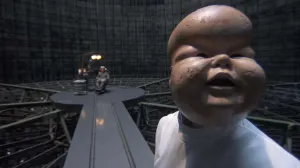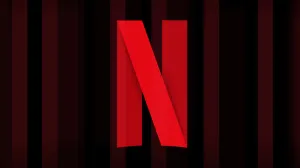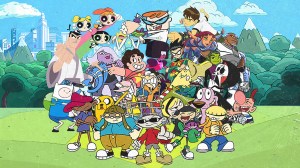Tomorrow sees the DVD and Blu-ray release of The Death of Superman, a Warner Bros. Home Entertainment/Warner Bros. Animation release that sees Superman (again) face off with Doomsday, resulting in their mutual deaths.
Videos by ComicBook.com
And while the movie is far closer in its content and tone to the comics than any previous incarnation of the story (which has been told a few times at this point, in live-action and animated), it still makes a handful of key changes.
And what kind of fans would we be if we did not take stock of them and see which ones did and did not meet our approval?
Well, we are not that kind of fans. We are the kind of fans who do exactly that thing. As you can see…!
Worst: Lex Luthor

Rainn Wilson is a gifted comedic actor with a lot of range, and we were excited to hear him step into the iconic role of Lex Luthor…
…but it just did not quite click.
Wilson’s voice still had the air of Assistant to the Regional Manager; he sounded small, his voice quaked, and when he made his grand (delusional?) proclamations as Lex, they came off sounding not defiant but petulant.
Taking on a radically different version of Lex is nothing new to “The Death of Superman.” In the comics, the Doomsday story came at a time when Lex was officially dead, having put his brain into a younger, fitter, body he had cloned for himself. Sporting a thick mane of red hair, a beard, and an Australian accent, he impersonated his own illegitimate son and managed to clear himself of his “father’s” crimes while retaining access to the LexCorp assets.
This whole elaborate thing would have been a lot to try and fit into the film, and there is a nice little Easter egg to the “Aussie Lex” in the movie, but removing it just to give a weaselly, smarmy version of Lex rather than a cool and collected one feels like a bad calculation.
Putting Lex on the scene at every stage of the story, as if he were somehow an essential element of the Doomsday tale, is equally baffling: having LexCorp divers inspecting the asteroid that brings Doomsday to Earth becuase on a monitor he thinks the rock “looks pregnant,” and then having him jump into a suit of Kryptonite-powered armor to try and take down the monster…meh. We could do without any of that. Lex is a great character, but “The Death of Superman” was never much of a Lex Luthor story.
Moreover, for him to say that Doomsday killing Superman “would save me a lot of trouble” is a bit out of character…maybe not for Lex as a whole, but certainly for this storyline. In his most famous scene in “Funeral For a Friend,” Lex gloats over the coffin, exalting in having outlived his nemesis…but during the battle itself? He didn’t want any hand but his own to be responsible for putting Superman in the ground.
Best: Reinventing the League

This one is a bit on the controversial side. There are some good and bad elements that come out of it, so we will balance it by looking at each in their turn.
In the original comics, the Justice League of “The Death of Superman” was a hodgepodge group, mostly leftovers from Keith Giffen and J.M. DeMatteis’s long runs on Justice League International, Justice League Europe, and Justice League America. Writer/artist Dan Jurgens, who at the time was also writing and drawing Superman, had only been on the book for about a year when it came time to thread the “Doomsday!” and “Funeral For a Friend” storylines through Justice League America #69 and #70.
Jurgens used the opportunity to clean house, taking B- and C-list characters like Maxima, Bloodwynd, Fire, Ice, Blue Beetle, and Booster Gold out of action in the course of the fight — and not putting all of them back on their feet.
For many fans, the question of where Batman, or Green Lantern, or whomever, was during the hours of the Doomsday attack was one that nagged at them — and using the Big Seven Justice League resolves that question.
For those “in the know,” the way certain characters are presented also provides the fun of seeing the original story through the lens of the modern interpretation. Nathan Fillion is perfectly cast for a Hal that is a little cocky and even smarmy at times, a little too sure of himself, and thus able to stand in for Guy Gardner. Rosario Dawson as Wonder Woman is not only inspired casting on its face, but gives her warrior spirit a hard edge that eases the transition from the antihero Maxima.
Worst: Reinventing the League

So what is the downside?
Well, first of all, this is the thirtieth or fortieth time the “Death of Superman” storyline has been adapted, and for fans of the comic — one of DC’s best-selling of all time — it would be nice to see it translated as close to 1:1 as possible.
That is what it is, but there is also a weird little continuity question raised by this version of the League.
Namely: where is everyone else?
Having B- and C-listers on the League meant a lot of fans, as we noted before, would wonder aloud where Batman and Wonder Woman were during all of this. But having Batman, Wonder Woman, and a Green Lantern in good standing on the team begs the question: where was the Bat-family? Where was the Green Lantern Corps? The Atlantean army? The Amazons?
The same basic answer that fans had earned No-Prizes for over the years — that Doomsday’s attack was so fast and ferocious that other heroes simply did not hear about it in time, or have time to react or to relocate — could apply here…but with Batman and Hal Jordan close at hand, that explanation strains credulity even more than it did in the past.
Best: The Streamlining

Introducing characters like Dabney Donovan, John Henry Irons, Dan Turpin, Maggie Sawyer, and Hank Henshaw into the story could easily have bogged down the proceedings. Weighing in at 85 minutes or so, the movie is too short to have given us the “real” versions of any of these characters’ origins.
The movie does an admirable job of bringing characters and concepts central either to that era of the Superman titles, or to the upcoming sequel (Reign of the Supermen, coming next year), in a way that does not hijack the main narrative.
Some of those ideas had originated in other places — Roger Stern’s great novelization The Death and Life of Superman had to grapple with how to include essentially 7 years of ongoing comics continuity into a single novel, and Dirk Maggs’s Superman: Doomsday and Beyond radio play had to make similar decisions with even more cuts — but others started and ended with this movie and in many cases they were inspired choices that will make watching the second “half” easier on potential new audience members who tuned in because they heard good things about this one.
Worst: The updates

Updating “The Death of Superman” is a necessary evil — but certain elements of the movie feel a bit like they were updated unnecessarily, and that the work suffered as a result.
The simpler, more modern Metropolis is an understandable stylistic and practical choice for contemporary animators to make, but the city as depicted from 1986 until 1999 or so had a distinctive look and feel that made it, for once, competitive with Gotham in terms of its distinctive environments.
Making things more sleek made some ideas work really well — when a building is all glass, having it shatter as the soundwaves from Superman and Doomsday’s powerful blows ripple out is an easy visual to sell — it also takes away the distinctive look and feel of the era. In some cases, the changes are for the better — did Lois really need those shoulderpads? — but others just feel arbitrary, and the decision to stick with the New 52 Superman costume…well, what were we saying about things feeling dated?
Let’s add to that the New 52 Doomsday, which has already been abandoned both in the mainstream comics and on Krypton. Having the giant ram’s horn thing going on makes him look less badass and more like a reject from one of the early generations of Savage Dragon‘s Vicious Circle.
Best: Doomsday

We weren’t crazy about the look of Doomsday — and particularly of the bizarrely over-detailed suit he was wearing — but since “hidden away inside of a chamber below the Earth” had already been done in the subpar Superman: Doomsday animated movie once upon a time, it seemed the movie decided they needed a new origin for the monster.
Where Smallville and Batman v Superman: Dawn of Justice had gone in over-complicated directions to tackle this, The Death of Superman kept it pretty simple: while the exact time, place, and nature of his being deposited on Earth differs significantly from the way it happens in the comics, the mystery of exactly who and what he is remains.
We live in an era of everything being over-explained. Both Zack Snyder and the Russo brothers seem manifestly incapable of getting away from social media and allowing their films to speak for themselves, while fans dissect things frame by frame to find elaborate conspiracy theories that, for some, enhance the viewing experience.
Sometimes, though, over-explaining things does not improve them. Giving the long-mysterious Wolverine a specific origin, and then building on it over and over again with increasingly commplicated additions, did little to make the character more interesting.
The same tends to be true for Doomsday. The Superman/Doomsday: Hunter/Prey miniseries deepened the concept of the character and made him more interesting by explaining where he came from, but that worked because it was a story unto itself (and could be a solid sequel if all these movies do well, guys — wink wink, nudge nudge). Complicating “The Death of Superman” with a digression about Doomsday’s backstory doesn’t make it richer, only slower, and in reinventing his introduction, the filmmakers elected to retain his mysterious side — something that helped inform his status as a menacing force of nature.
Best: The way Doomsday died

Comic book purists may note that a “broken neck” does not really make sense for a character who does not have bones as we traditionally understand them (see Superman/Doomsday: Hunter/Prey for more on this), but the fact remains the resolution to the Superman/Doomsday conflict is dealt with very well in the movie.
In the comics, the pacing of the final battle was calculated and near-perfect for the medium — but in live action, it is more exciting to watch Doomsday being a threat right up until the final possible second.
In both the comics and in the movie, there had to be a plausible threat that Superman might not make it out of the fight alive, and the way they did that in both cases (to varying extents) was to have Doomsday be such an overwhelming force that it really just never looked like Superman wouldn’t lose.
Unable to really approximate the pacing of a comic onscreen, the filmmakers used motion and timing in a way specific to their own medium to come up with an equally shocking and visceral final blow between the titans.
Best: The Funeral

First of all, knowing that there would not be time in a movie this short for a closer adaptation of the 8-part “Funeral For a Friend,” or the oversized The Adventures of Superman #500, in which Jonathan Kent has a heart attack, a near-death experience, and brings his son back to the land of the living with him, the idea of getting the heart of “Funeral” — the way Superman’s death saddens and rocks the world — in a few moments of montage is inspired.
At the time of its publication, “Funeral For a Friend” included a cameo appearance by Bill and Hillary Clinton, who had been elected but not yet inaugurated at the time the comics were being created.
The idea was to lend the comics a sense of verisimilitude, as well as counting on the goodwill of fans seeing for the first time a newly-minted President in their comics, at a time that was at least slightly less politically-polarized in the U.S.
The downside is that a “real-world” President and First Lady have made elements of the collected editions feel as dated as the technology being used in the newsroom.
Skirting both the “dated” feeling that including current U.S. President Donald Trump would eventually create and the difficulties of depicting a controversial President in a divided country, and replacing him with a fictional DC Universe President is a good idea. Even just something as simple as deciding how best to portray the President could be a problem, since both voice acting and animation work in a lot of caricature, but most of Trump’s most easily caricatured traits have been used by his sharpest critics, meaning that a seemingly innocuous impression or depiction could easily be perceived as offensive or look like an attack or a parody.








